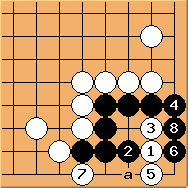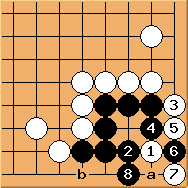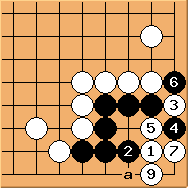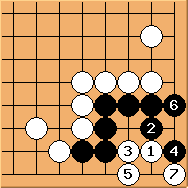 Previous | Index | Next Previous | Index | Next 

Diagram 11.1: White to play
How does the extra bend at  affect the outcome? affect the outcome?

Diagram 11.2: Solution 1
 is normally not a good move in standard Carpenter's square shapes covered earlier but it is good now. is normally not a good move in standard Carpenter's square shapes covered earlier but it is good now.
 is important to help form a seki.
If is important to help form a seki.
If  plays 8 instead, black simply plays 'a' and white is one liberty too short in the capturing race. plays 8 instead, black simply plays 'a' and white is one liberty too short in the capturing race.

Diagram 11.3: Solution 2
If white plays  black needs to be careful. black needs to be careful.
 is a calm move. In the end 'a' and 'b' are miai so black is unconditionally alive. is a calm move. In the end 'a' and 'b' are miai so black is unconditionally alive.

Diagram 11.4: Black fails (8=3)
If black is tricked into playing  ,
following ,
following  and and  , both forcing moves, , both forcing moves,  is good.
Black can win the capturing race by playing 'a' but that is a T-four dead shape.
So black corner is completely dead. is good.
Black can win the capturing race by playing 'a' but that is a T-four dead shape.
So black corner is completely dead.

Diagram 11.5: Black fails too
 from the other side is normally incorrect. from the other side is normally incorrect.
 is the best point.
Apart from is the best point.
Apart from  , playing anywhere else would result in a big-eye killing shape (please verify).
So there is a messy ko fight now.
In practice, if black isn't happy with Solution 1 (where all his points are gone), and he has plenty of ko threats,
it may be worthwhile to try this diagram. This corner is a two-stage ko, and for black to win an approach move is needed.
So winning this ko won't be easy for either side, a good way for black to complicate situations on the board. , playing anywhere else would result in a big-eye killing shape (please verify).
So there is a messy ko fight now.
In practice, if black isn't happy with Solution 1 (where all his points are gone), and he has plenty of ko threats,
it may be worthwhile to try this diagram. This corner is a two-stage ko, and for black to win an approach move is needed.
So winning this ko won't be easy for either side, a good way for black to complicate situations on the board.
Conclusion: Black's corner should be unconditionally alive, unless he chooses other options.
 Previous | Index | Next Previous | Index | Next 
|  Previous | Index | Next
Previous | Index | Next 





 Previous | Index | Next
Previous | Index | Next 
 affect the outcome?
affect the outcome? is normally not a good move in standard Carpenter's square shapes covered earlier but it is good now.
is normally not a good move in standard Carpenter's square shapes covered earlier but it is good now.
 is important to help form a seki.
If
is important to help form a seki.
If  plays 8 instead, black simply plays 'a' and white is one liberty too short in the capturing race.
plays 8 instead, black simply plays 'a' and white is one liberty too short in the capturing race. black needs to be careful.
black needs to be careful.
 is a calm move. In the end 'a' and 'b' are miai so black is unconditionally alive.
is a calm move. In the end 'a' and 'b' are miai so black is unconditionally alive. and
and  is good.
Black can win the capturing race by playing 'a' but that is a T-four dead shape.
So black corner is completely dead.
is good.
Black can win the capturing race by playing 'a' but that is a T-four dead shape.
So black corner is completely dead.